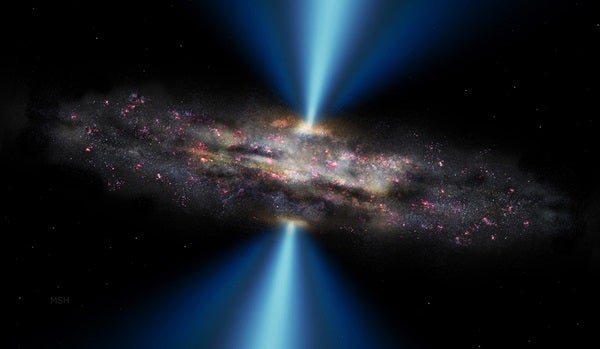The data, collected with Keck Observatory’s newest instrument called MOSFIRE, revealed a giant black hole in a galaxy called CID-947 that is 11 billion light-years away. The incredible sensitivity of MOSFIRE coupled to the world’s largest optical/infrared telescope meant the scientists were able to observe and characterize this black hole as it was when the universe was less than 2 billion years old, just 14 percent of its current age — almost 14 billion years have passed since the Big Bang.
Even more surprising than the black hole’s record mass was the relatively ordinary mass of the galaxy that contained it.
Most galaxies host black holes with masses less than 1 percent of the galaxy. In CID-947, the black hole mass is 10 percent that of its host galaxy. Because of this remarkable disparity, the team deduced this black hole grew so quickly that the host galaxy was not able to keep pace, calling into question previous thinking on the co-evolution of galaxies and their central black holes.
“The measurements of CID-947 correspond to the mass of a typical galaxy,” Trakhtenbrot said. “We therefore have a gigantic black hole within a normal-sized galaxy. The result was so surprising, two of the astronomers had to verify the galaxy mass independently. Both came to the same conclusion.”
“Black holes are objects that possess such a strong gravitational force that nothing — not even light — can escape,” said Meg Urry of Yale University in New Haven, Connecticut. “Einstein’s theory of relativity describes how they bend space-time itself. The existence of black holes can be proven because matter is greatly accelerated by the gravitational force and thus emits particularly high-energy radiation.”
Until now, observations have indicated that the greater the number of stars present in the host galaxy, the bigger the black hole. “This is true for the local universe, which merely reflects the situation in the universe’s recent past,” Urry said.
Furthermore, previous studies suggest the radiation emitted during the growth of the black hole controlled, or even stopped, the creation of stars as the released energy heated up the gas. This cumulative evidence led scientists to assume the growth of black holes and the formation of stars go hand-in-hand.
The latest results, however, suggest that these processes work differently, at least in the early universe.
The distant young black hole observed by Trakhtenbrot, Urry, and their colleagues had roughly 10 times less mass than its galaxy. In today’s local universe, black holes typically reach a mass of 0.2 to 0.5 percent of their host galaxy’s mass. “That means this black hole grew much more efficiently than its galaxy, contradicting the models that predicted a hand-in-hand development,” Trakhtenbrot said.
The researchers also concluded stars were still forming even though the black hole had reached the end of its growth. Contrary to previous assumptions, the energy and gas flow propelled by the black hole did not stop the creation of stars.
“From the available Chandra data for the source, the researchers also concluded that the black hole has a very low accretion rate and has therefore reached the end of its growth. On the other had, other data suggests that stars were still forming throughout the host galaxy,” Trakhtenbrot said.
The galaxy could continue to grow in the future, but the relationship between the mass of the black hole and that of the stars would remain unusually large. The researchers believe CID-947 could be a precursor of the most extreme massive systems that we observe in today’s local universe, such as galaxy NGC 1277 in the constellation of Perseus, some 220 million light-years away from our Milky Way.










